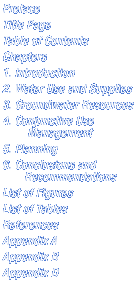 |
|
Chapter
1: Introduction Recent years, however, have seen a number of problems emerge with implications for the future of the County's water system and the way it is managed. These problems, often associated with groundwater pumping, have been intensified by the current California drought. Deteriorating groundwater quality, compaction of aquifer materials with consequent surface subsidence, and the unplanned transfer of both surface and groundwater supplies outside the County during droughts are all potential threats to the sustainability of the County's water system if they are allowed to continue. When faced with water supply problems, the historical trend in Yolo County has been to propose importing or developing new surface water supplies from outside the County. These past efforts have generally been successful and imports have served to reduce groundwater pumping and postpone having to actively manage groundwater overdraft problems. Today, however, this approach may have limited practicality for Yolo County's water future because the increasingly competitive environment for limited surface water supplies in California will make it much more difficult for Yolo County to get more imports. Indeed, some of its existing surface supplies could be lost to growing urban and environmental demands outside the County if unregulated water marketing is allowed in the State. Developing new surface supplies will also be more costly than in the past, given the environmental concerns and costs of dams. On the other hand, groundwater under Yolo County, if actively managed, is generally a much lower cost alternative, a more reliable water supply during droughts and surface water shortages, and offers many other advantages over surface water imports. The County has experienced very little hardship and has been able to sustain virtually normal levels of economic activity in this current drought because of its groundwater resources. Moreover, the likelihood of more frequent surface water shortages in California, as urban and environmental demands on existing supplies increase, accentuates further the differences in reliability between surface imports and local groundwater supplies, Conjunctive use water management, the integrated management of ground and surface water resources, offers a different approach for addressing water problems in the County. Conjunctive use management can increase the yield of the overall water system by using existing resources more effectively and efficiently without necessarily turning to new more expensive and less reliable surface water imports. By coordinating the use of surface and groundwater supplies in different parts of Yolo County at different times, in response to varying conditions inside and outside the County, the overall use of the County's water supplies can be improved in the short term and sustained in the long term. Conjunctive use management can concurrently address the groundwater depletion concerns of the present water supply system, strengthen the County's position for managing water transfers, and ensure the adequacy of the County's groundwater resources for periods of drought and surface water shortages. During droughts in Yolo County, surface water shortfalls and lack of rain are made up for by pumping more groundwater. The condition of the groundwater basin at the beginning of a drought is critical to maintaining adequate water supplies for both agricultural and urban water users throughout drought events. However, considered as a single physical unit, groundwater is presently unmanaged and lacks any responsible agency oversight, yet it is perhaps the single most important and reliable water supply for the County. Groundwater management is a fundamental cornerstone of conjunctive use management. One important component of conjunctive groundwater management is the use of wet-year excess surface water supplies to artificially recharge groundwater in order to sustain groundwater yield and recover lost storage after periods of drought. The objective of this report is to explore some concrete possibilities for improving Yolo County's water supply system by County-wide conjunctive use management of its surface and groundwater supplies. One major benefit of conjunctive management would be the protection and enhancement of the County's groundwater resources through their active management. While a number of County planning reports (Borcalli, et al., 1984; Borcalli and Associates, 1992a) and technical studies (Scott, et al., 1975 ; Borcalli and Associates, 1990) have made general reference to conjunctive use management and artificial recharge as important water management strategies, the information provided has lacked depth, detail, and completeness. It is hoped that this investigation will provide enough background, information, and direction to stimulate discussions of conjunctive management strategies, and their implementation for the County's water future. This report is organized into the following Chapters. Chapter 2 provides a comprehensive description of Yolo County's water system, including estimates of current and projected water uses and average supplies. Chapter 3 explores in detail the County's groundwater resources, their use and the sustained yield of the basin. Variations from average water use and supply conditions in different parts of the County, at different times of the year, and during droughts and surface water shortages, are evaluated for their impacts on groundwater in Chapter 3. Ultimately it is these deviations from average, and the problems and opportunities they present for the County's water system, that will shape effective conjunctive use management plans. Chapter 4 introduces specific proposals for conjunctive use schemes and describes how they might work in Yolo County. Many of the schemes involve ways to reshape and manage the balance between different water uses, and the mix and match of available supplies for those uses, while giving full attention to related groundwater environmental concerns. Constraints on implementing County-wide conjunctive use management, and some implications for planning are discussed in Chapter 5. In Chapter 6 the report is concluded and some recommendations for improving Yolo County's water system are presented. |
|
previous section | top of page | next section |
Preface Title Page Table of Contents
2. Water Use
3.Groundwater Resources
4. Conjunctive Use 5. Planning
6. Conclusions/Recommendations
List of Figures List of Tables References
Appendix A Appendix B Appendix D